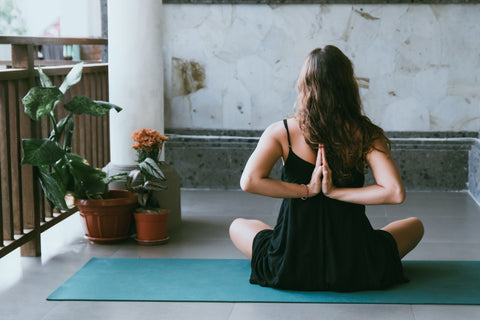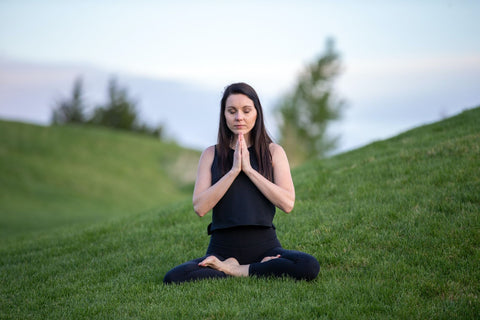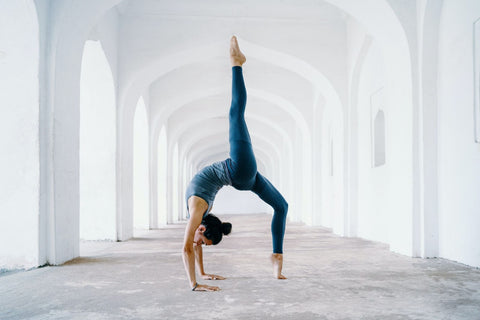
While for some meditation is the practice that involves slowing down their thoughts in order to clear their mind, for others it is a way of life. Why does it become so important to some practitioners? Because meditation is an art that offers an array of meaningful benefits that increase one’s well-being. These benefits include but are not limited to decreasing blood pressure, helping practitioners sleep better, improving the power of one’s immune system, and relieving stress, depression, and anxiety.
Yoga is a form of meditation that promotes your happiness and well-being. Both practices have similar goals: to help us attain clear and focused minds and a heightened sense of self. In this guide, we will share with you steps to help you use yoga to facilitate meditation in order to reach the peace and happiness you deserve.
1. Practice Often
The first step to successfully achieving results through meditation is to do it often. Practicing yoga as a form of meditation each day is the best way to work towards inner peace and happiness. While this can seem like a big commitment, beginning by practicing for as little as three to five minutes a day can have beneficial effects.
Try choosing a designated time each day to commit to practicing meditation in order to hold yourself accountable while you are developing the habit.
2. Choose a Yoga Spot
You should select a spot that is comfortable, quiet, and that has enough room to allow you to move around as yoga dictates and demands. Choosing a spot devoid of distractions is vital to practicing, as meditation revolves around focusing on the present moment and carefully controlling your thoughts and mind.

3. What’s Your Pose?
Next, decide the position you would like to be in while practicing meditation. The most common is to be sitting on the ground. Some common poses to use in the seated position are Easy Cross-Legged Pose or Lotus Pose, especially for those who are more flexible.
It’s important to ensure that you are comfortable while meditating. You may even want to place a cushion or blanket underneath you to maximize comfort. Some feel more at ease in a chair, and oftentimes that is a great starting point for beginners. As long as you are sitting upright comfortably, that is what matters most.
4. Relax Your Muscles
Relax your arms and place them on your thighs or lap--whatever feels most natural for you--facing your palms either upward or downward. After rolling your shoulders back and down, slowly lift your chest. Be sure to keep your neck long and your chin tilted downward. You may choose to leave your eyes open or closed.

5. Focus Your Energy
Focus your thoughts and energy on one thing, such as the flame of a burning candle or on breathing in and out while holding your yoga pose. Alternatively, you can close your eyes and focus on yoga humming in order to achieve the peace of mind that accompanies meditation. Because meditation is a form of training your mind, it’s important to use this time to stay clear of distractions.
In our day-to-day lives, our minds are almost always cluttered with worry, daydreaming, or other thoughts that can leave us stressed and anxious. That is what makes the art of yoga and meditation so important and so impactful when practiced correctly and often.
6. Redirect if You Lose Concentration
Should you notice your mind wandering, not to worry. That will certainly be the case at times, especially when you are beginning to build your meditation regime. When your thoughts begin to veer away from whatever you are supposed to be solely focused on, simply redirect your attention back to where it is meant to be and continue the exercise.

7. Affirmations
As you become more comfortable meditating, begin using affirmations in conjunction with focused breathing to induce further mental and spiritual benefits. Inwardly repeat mantras such as, “I am relaxed,” or, “my mind is clear”, as you breathe out to center yourself and to control your focus.
8. Be Patient
The most important part of practicing meditation is to have patience in your journey. Feel free to mix up your routine each day, adjusting the poses and position you practice in. As you grow into your meditation routine and begin to lengthen it, always ensure you are doing what is comfortable for you and your body. Making adjustments to your positioning and style as your mind and body dictate will only enhance your experience and help you to achieve happiness and serenity in a better way.

The Connection Between Meditation and Happiness
But how does following this meditation regime have a positive effect on our minds? Research points to the fact that practicing meditation regularly physically changes our brains in several ways. First, studies show that frequent meditation can decrease the activity in the default mode network (DMN) of the brain. This “me center” is responsible for mind-wandering, which typically leads to worrisome thoughts about the present and future. This quieting effect on the DMN allows for practitioners to feel happier and less anxious.
The same Forbes article also reports that regular meditation is capable of reducing symptoms associated with depression and anxiety. In fact, research shows that the size of the effect on these symptoms is about equivalent to that of antidepressants, making this a great tool to assist in managing symptoms.
Finally, a study revealed that as little as a few weeks of practicing meditation can help improve concentration levels. The study tested participants focus and memory during the verbal reasoning section of the GRE test, and their score increased an equivalent of 16 percentile points--which is pretty impressive!
These effects are undeniable, and the best part is that they are extremely attainable for anyone who participates in meditation regularly.
Overcoming Common Meditation Challenges
Even with all of the benefits, there are still several common meditation challenges that you may experience in your quest for inner peace. One frequent hurdle is becoming sleepy when you begin meditating. To combat this issue and to stay alert, you can try straightening your posture, opening your eyes, or focusing more heavily on sounds rather than your breathing.
Another common obstacle is that you may experience physical pain or discomfort while meditating. Your legs may fall asleep or you may struggle with aches and cramps. Besides adjusting your posture and positioning, to help accommodate this pain you should accept it as a passing feeling and try to direct your attention to an alternate part of your body as you wait for it to pass.
Another common challenge is the feeling of restlessness during meditation. Especially for those who are used to constantly being on the go, meditation can feel boring at first. To avoid this feeling and to remain engaged, focus on specific sensations of the practice such as your breathing.
On your quest to becoming a regular meditation practitioner and attaining happiness, make sure to keep your expectations realistic. You won’t become an expert overnight, and like with anything, meditation takes commitment and work. Keep in mind that it’s worth the patience as the impact it will have on your life as a whole will be profound. Using yoga as a venue to promote our own meditation skills is a great way to feel more relaxed, centered, and calm in all aspects of our lives.






